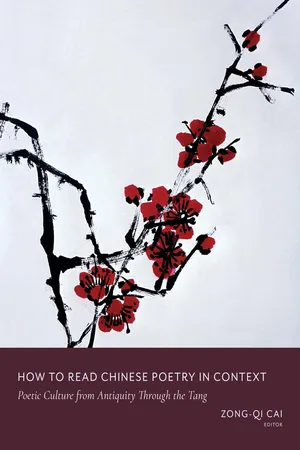1
POETRY AND DIPLOMACY IN ZUO TRADITION (ZUOZHUAN)
The Book of Poetry (Shijing; ca. 1000–ca. 600 BCE), comprising 305 poems, is a foundational text in the Chinese tradition not only because of its antiquity and the range of human experience it encompasses but also because of its significance for understanding early thought, history, rituals, and politics. Scholars argue about the dating and origins of the Poetry; when, how, and why did this text come into being? What might have been the social, ritual, and political contexts for the performance of the poems that come to be collected in the Poetry?
Mencius (ca. fourth century BCE) claimed that the ideal interpreter of the Poetry “uses his mind to meet the intent [of the author]” (yi yi ni zhi; Mengzi 6A.4). The context of that remark is Mencius’s critique of his interlocutor’s wrong interpretation. This confirms how “authorial intention” is used to uphold one valid interpretation and to exclude other readings. The immensely influential Mao Preface to the Poetry, which cannot be dated with certainty but probably came into being no later than the first century, describes poetry as the product of affective response and inevitable expression. Predating reflections on authorial intention or the process of poetic creation, however, are instantiations of how poems that come to be collected in the Poetry can be used for political purposes.
Some of the earliest extant writings on Chinese literary thought thus pertain to the political functions of poetry. Confucius famously remarked, “If one does not study the Poetry, one does not have the wherewithal for proper speech” (Analects 16.13).1 “Speech” here refers to political communication, as is evident in this explanation: “If, having recited three hundred poems, a person cannot achieve his goals when given a position of political responsibility, or if he cannot respond independently when being sent as envoy to domains in the four directions, then what purpose does it serve even if he knows many poems?” (Analects 13.5). These sayings attributed to the sage likely appear after, or may be inspired by, recorded instances of Eastern Zhou (770–256 BCE) aristocrats who recited the poems to convey their political vision, policy recommendation, or diplomatic finesse. Most of these examples are found in Zuo Tradition (Zuozhuan, hereafter Zuo), a vast repertoire of narratives and speeches related to events spanning 255 years (722–468 BCE) and traditionally understood as an exegetical tradition of the Spring and Autumn Annals (Chunqiu) (figure 1.1).
This was a period when many different domains vied for power and influence or struggled to survive, often through diplomatic rhetoric. Mastery of this language—what Confucius calls the competence to respond independently (zhuandui)—includes using apposite quotations from the Poetry, which are usually embedded in longer speeches, as well as the skill of fushi, variously translated as “reciting,” “chanting,” or “singing” the poems. The accounts of such performances would include the terse formula of “X (subject) chants (fu) Y (a poem),” a concise delineation of the occasion and the context (usually a state visit, an interstate meeting, or a semiformal exchange between members of the elite), and the reaction of the addressee, often in the form of reciprocal fushi. On rare occasions, fu can mean “composition,” but in most cases it refers to the appropriation of existing pieces. Many of these are found in the received text of the Poetry, and the few that are not are traditionally classified as “lost poems” (yishi). With rare exceptions, the actors in these stories are men.2 In most cases, the poem is just mentioned by name rather than cited. This is cultural shorthand; the reader has to already know the Poetry in order to understand the import of the exchange.
FIGURE 1.1 Rubbing from pictorial relief carving of four registers depicting mythical animals, female figur...

